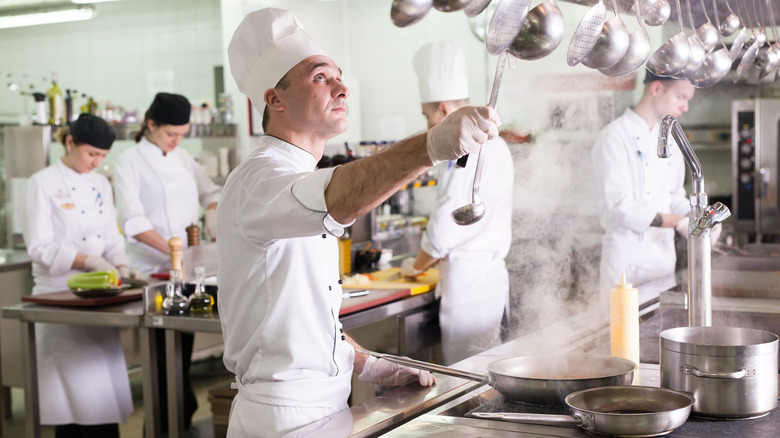What Does The Term 'Kitchen Brigade' Actually Mean?
When you see a restaurant's white-jacketed, capped, and often shouting personnel flourishing utensils and flinging food, the term "kitchen brigade" makes intuitive sense. Only a military metaphor could capture the close-knit efficiency observed through a wave of dinner orders. Except the idea of the kitchen brigade is less a metaphor than an actual attempt to instill a military-style order into the chaos of the kitchen.
When the Franco-Prussian war broke out in 1870, 24-year old Auguste Escoffier enlisted with the French army. Previously, as the Musée Escoffier explains, he had worked his way from restaurants in Nice to Paris, so he served as a chef for the general staff at the Army of the Rhine. The French lost. However, Escoffier led a successful career afterwards bringing aspects of his army experience to the kitchen, including the hierarchical structure of the brigade de cuisine, or kitchen brigade.
The point of the kitchen brigade was to ensure that every chef had a clear role that they would focus on fulfilling. These roles were performed within a strict hierarchy, and younger chefs would move upwards through the ranks as their career progressed. Culinary Lore lists the ranks in descending order as the Chef de Cuisine, the Sous Chef, the Chef de Partie, the Demi-Chef, the Commis, and the Apprentice. The Chef de Partie, or station chef, occupies the part of the chain where the command structure spreads throughout the kitchen, with one for sauces, one for pastries, and so on.
A new structure for new times
The kitchen brigade emerged at a time when the idea of chefs was still in the process of decoupling from the military and nobility. Austin Chronicle, for example, notes how the role of the chef probably evolved from the army cook who had to find work once the military campaign had finished. So, that large hierarchical organization was very much of its time.
Today, we live in a world that prizes words like "entrepreneur" and "flexible." Reluctant Gourmet argues that the kitchen brigade of today reflects this time as it had reflected the time of the 19th century. Because of the high rental costs for restaurants today, kitchen size is minimized, which results in a small kitchen crew. By their estimate, a restaurant's kitchen staff could consist of three to four people on weeknights and six to seven on weekends. The highest estimate is barely larger than if Escoffier only hired one person for each rung on his hierarchical ladder.
Even though the Reluctant Gourmet presents a lengthy list of the roles in the kitchen, they also admit that in most modern kitchens, the chefs probably multitask and are trained to jump from station to station at a moment's notice. There is still an executive chef and roles more senior than others, but the assumption that one person will do the roles that used to be under the control of one person indicate the added expectations that are now mainstream.

